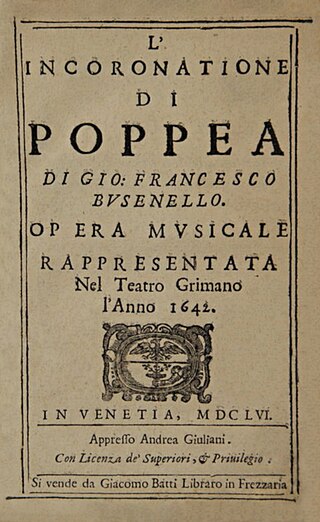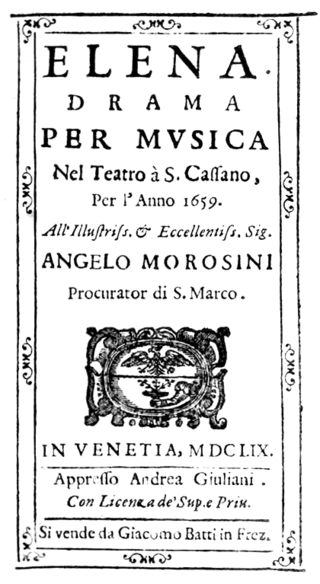
Francesco Cavalli was a Venetian composer, organist and singer of the early Baroque period. He succeeded his teacher Claudio Monteverdi as the dominant and leading opera composer of the mid 17th-century. A central figure of Venetian musical life, Cavalli wrote more than forty operas, almost all of which premiered in the city's theaters. His best known works include Ormindo (1644), Giasone (1649) and La Calisto (1651).
Raymond John Leppard was a British-American conductor, harpsichordist, composer and editor. In the 1960s, he played a prime role in the rebirth of interest in Baroque music; in particular, he was one of the first major conductors to perform Baroque opera, reviving works by Claudio Monteverdi and Francesco Cavalli. He conducted operas at major international opera houses and festivals, including the Glyndebourne Festival where he led the world premiere of Nicholas Maw's The Rising of the Moon, the Metropolitan Opera and the Royal Opera House. He composed film scores such as Lord of the Flies and Alfred the Great.

L'incoronazione di Poppea is an Italian opera by Claudio Monteverdi. It was Monteverdi's last opera, with a libretto by Giovanni Francesco Busenello, and was first performed at the Teatro Santi Giovanni e Paolo in Venice during the 1643 carnival season. One of the first operas to use historical events and people, it describes how Poppaea, mistress of the Roman emperor Nero, is able to achieve her ambition and be crowned empress. The opera was revived in Naples in 1651, but was then neglected until the rediscovery of the score in 1888, after which it became the subject of scholarly attention in the late 19th and early 20th centuries. Since the 1960s, the opera has been performed and recorded many times.

L'Ormindo is an opera in a prologue and three acts by Francesco Cavalli to an original Italian libretto by Giovanni Faustini. The manuscript score is held at the Biblioteca Marciana in Venice, while a copy of the original libretto has been digitized by the Library of Congress. The opera has set numbers with recitative, and is set in Anfa (Casablanca), in the Mauri kingdom of Fessa (Fez).

Giove in Argo is an Italian opera by George Frideric Handel. It is one of Handel's three pasticcio works made up of music and arias from his previous operas. The libretto was written by Antonio Maria Lucchini. The opera was first performed at the King's Theatre, Haymarket, London, on 1 May 1739.
Antonia Padoani Bembo was an Italian composer and singer.

Anna Renzi was an Italian soprano renowned for her acting ability as well as her voice, who has been described as the first diva in the history of opera.

Il Xerse is an Italian opera by Francesco Cavalli about Xerxes I. The libretto was written by Nicolò Minato and was later set by both Giovanni Bononcini and George Frideric Handel. Minato's plot outline is loosely based on Book 7 of Herodotus's Histories. The opera, consisting of a prologue and three acts, was first performed at Venice on 12 January 1655, at the Teatro SS. Giovanni e Paolo. It was dedicated to the Ferrarese nobleman Marchese Cornelio Bentivoglio.

Oristeo is an opera in a prologue and three acts by Francesco Cavalli. It was designated as a dramma per musica. The Italian libretto was by Giovanni Faustini.

Erismena is an opera in a prologue and three acts by Francesco Cavalli. First performed in Venice in 1655, it was designated as a dramma per musica.

L'Egisto (Aegisthus) is a 1643 opera in a prologue and three acts by Francesco Cavalli. It was designated as a favola dramatica musicale. The Italian libretto was by Giovanni Faustini, his second text for Cavalli.

Eritrea is an opera in three acts by the Italian composer Francesco Cavalli. The libretto is by Giovanni Faustini. It was premiered at the Teatro Sant 'Apollinare in Venice on 17 January 1652, and revived in modern times at the Wexford Festival in 1975 under the conductor Jane Glover.

Elena is a 1659 dramma per musica in a prologue and three acts by Francesco Cavalli. It is set to a libretto initiated by Giovanni Faustini and completed by Nicolò Minato, and it was first performed in Venice at the Teatro San Cassiano. Elena was revived in 1661 in Palermo but then not heard again until 2013, at the Aix-en-Provence Festival.
Giovanni Faustini was an Italian librettist and opera impresario of the 17th century. He is best remembered for his collaborations with the composer Francesco Cavalli.

Artemisia is an opera in three acts and a prologue by the Italian composer Francesco Cavalli from a libretto written by Nicolò Minato. It was first performed at the Teatro San Giovanni e San Paolo, Venice on 10 January 1657 and revived in Naples in 1658, Palermo in 1659, Milan in 1663 and Genoa in 1665.

Rosinda, also known as La Rosinda, is an opera in three acts and a prologue by the Italian composer Francesco Cavalli with a libretto by Giovanni Faustini. It was first performed at the Teatro Sant 'Apollinare, Venice in 1651-02 during Carnival. It appears to have been better received than La Calisto, which was also premiered that year, and was revived in Naples and/or Florence in 1653 under the title Le magie amorose.

The Teatro Santi Giovanni e Paolo was a theatre and opera house in Venice located on the Calle della Testa, and takes its name from the nearby Basilica of Santi Giovanni e Paolo, Venice. Built by the Grimani family in 1638, in its heyday it was considered the most beautiful and comfortable theatre in the city. The theatre played an important role in the development of opera and saw the premieres of several works by Francesco Cavalli, as well as Monteverdi's Il ritorno d'Ulisse in patria and L'incoronazione di Poppea.
Marco Faustini was an Italian theatrical impresario and brother of the impresario and librettist Giovanni Faustini.
Teatro Sant' Apollinare was an Italian public opera house established in 1651 in Venice in what is today Petriana Court. The Sant 'Apollinare was established in a residential building and equipped with advanced stage machinery intended to allow for spectacular stage shows. It was managed in 1651 by impessario and librettist Giovanni Faustini, who died during the first run of his opera La Calisto there. After his death, his brother Marco Faustini took over management of the theater. It was dismantled in 1661 and the rooms returned to residential use.
Barbara Daniels is an American operatic soprano.






